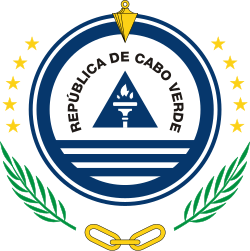Background and historical arms
On 8 May 1935, Portugal introduced a new coat of arms for its colonies, including Cape Verde, São Tomé and Principe, and Guinea-Bissau (then Portuguese Guinea). [3] The 1935 arms are described as follows: "All arms were of the same model: divided vertically in such a way that two sub-shields are formed. The dexter was white with five small blue shields each bearing five white discs (i.e. the “quinas cross” representing the motherland). The sinister represented the colony. In the base green and white waves to indicate the overseas location. To complete the badge, the arms were set upon a golden armillary sphere with a golden mural crown." [4] On July 11, 1951, a slightly revised version was introduced, which was used until July 5, 1975.
The replacement flag following independence in 1975, in use from then until 1992, used colours more typical of African nations, with red, green and yellow, almost identical to the flag of Guinea-Bissau. On the left in the red portion of the flag was the coat of arms, in use from July 5, 1975 until September 22, 1992 in its own right. It featured a large black star, surrounded by a saffron-yellow and green maize wreath and a scallop shell in the centre, also of a saffron/amber colour. [5] The independent coat of arms, not used on the flag, featured the same saffron-yellow and green maize wreath and a scallop shell in the centre at the bottom, but the star was smaller and complicated with several other features, including a flag poll and something resembling a book. The current national emblem of Cape Verde was adopted in 1992 at the same time as the national flag, 17 years after the island nation became independent. [1]
Gallery
Provisional
coat of arms of the
Portuguese colony of Cape Verde from June 1832, elaborated by Afonso Dornelas and proposed by the Portuguese Institute of Heraldry at the request of the Agency General of the Colonies.
Coat of arms of the Portuguese colony of Cape Verde, from May 8, 1935.
Coat of arms of the Portuguese province of Cape Verde from June 11, 1951.
Escutcheon of the colony and then province from May 8, 1935.
Coat of arms of Cape Verde from July 5, 1975.
Coat of arms of Cape Verde from September 22, 1992 to November 23, 1999.
This page is based on this
Wikipedia article Text is available under the
CC BY-SA 4.0 license; additional terms may apply.
Images, videos and audio are available under their respective licenses.






